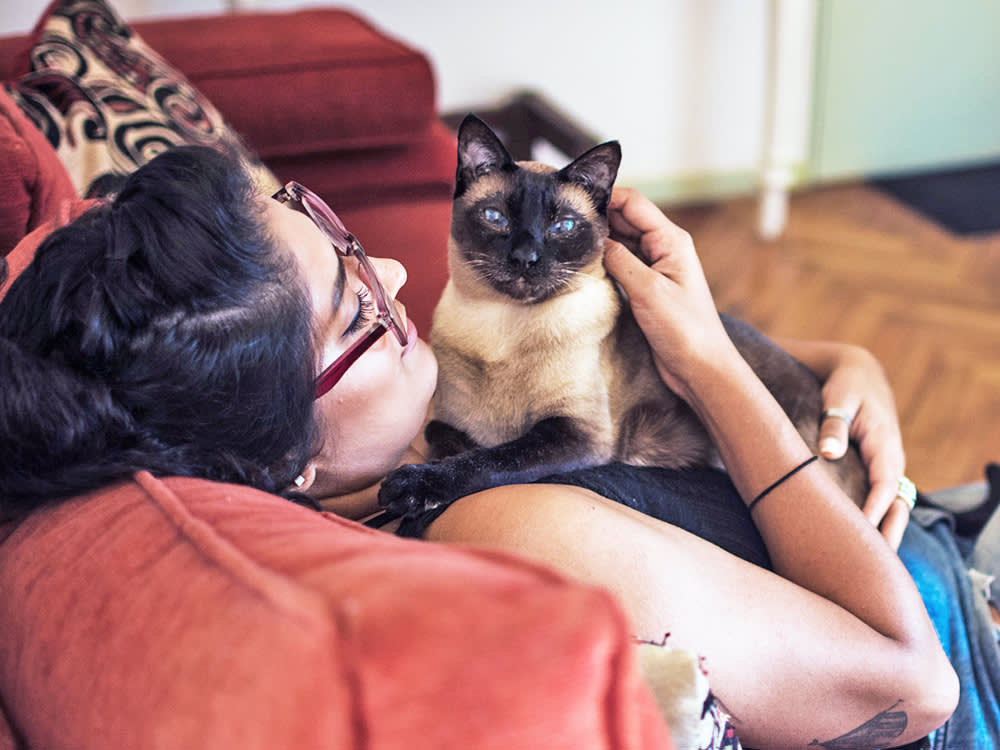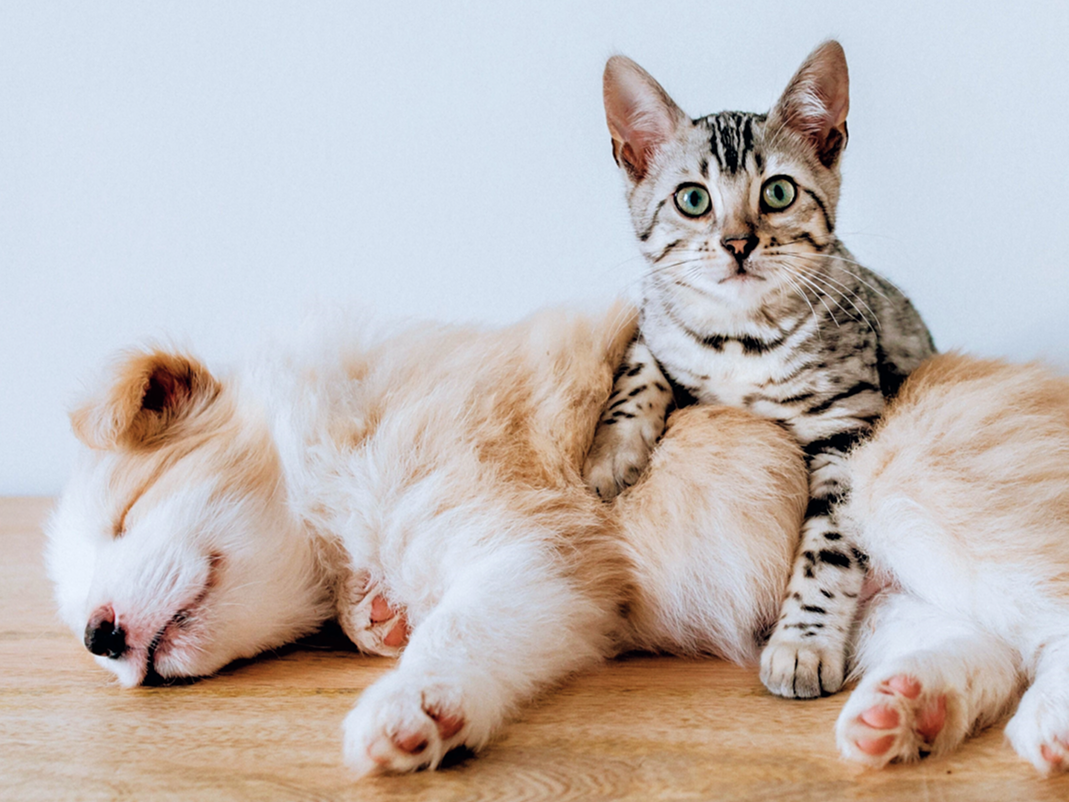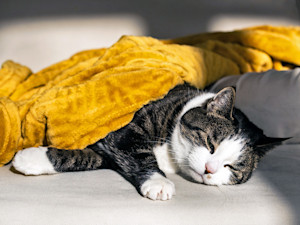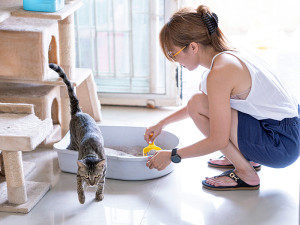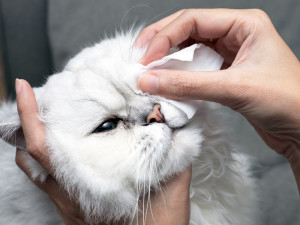Upper Respiratory Infection In Cats: Symptoms, Causes, And Treatment
Help your cat recover quickly and comfortably.
In This Article:
Common Symptoms of URIs in Cats Causes of URIs In Cats How to Diagnose URIs in Cats Treatment Options for URIs in Cats How to Prevent URIs in Cats
Cat sneezes may be cute, but when you’re hearing them with some regularity or if they’re accompanied by a snotty nose, coughing, or watery eyes, you may be looking at something that’s not cute at all: an upper respiratory infection (URI). Infections affecting the upper airways are very common in cats so, if your cat’s sneezing has gone from cute to worrisome, read on to learn more about upper respiratory infections.
Check out customizable policies from our friends at Lemonade Pet Insurance—so you only pay for what you need.
Common symptoms of URIs in cats
The upper respiratory system consists of the nose, mouth, sinuses, and pharynx. Most of the time, the signs of an upper respiratory infection are fairly mild and resemble the human common cold, but some cases of URIs may become more severe and require veterinary attention.
Sneezing
Irritation and inflammation in the nose can lead to sneezing as your cat tries to clear congestion. Sneezing may be frequent.
How much do you spend on your pet per year?
Nasal and eye discharge
Frequent sneezing may cause a snotty, runny nose which may be colored yellowish-green and be very thick or it could be clearer and liquidy. Kitties may also have watery eyes with a discharge that has the same thickness and color.
Coughing
If the infection involves areas of the throat, your cat may also cough as a way to relieve the irritation and move any phlegm. They may also be a little hesitant to swallow if they have a sore throat.
Fever
Some URIs can cause an elevation in body temperature as a cat’s immune system tries to fight the cause. You may be able to tell that their temperature is elevated by feeling your cat’s ears or the pads of their feet.
Loss of appetite
Cats really rely on their sense of smell when it comes to working up an appetite and finding food appealing, so it would make sense that if their nose is stuffed up and hampering their sense of smell, they also wouldn’t want to eat.
Lethargy
When you add up all of the above signs, you can imagine that a kitty would be feeling pretty crummy – enough so that they won’t feel like doing much and may choose to lay around most of the day, sleeping.
Causes of URIs in cats
URIs are caused by some fairly common bugs that cats may come in contact with on a regular basis. This means that most healthy adult cats, especially if they’ve been vaccinated, won’t get very sick. The kitties that you have to watch out for are young ones who are still developing their immune systems, older kitties, or cats who may be immune compromised. The causes of URIs may include:
Viral infections
Herpesvirus and calicivirus are the main viral problems when it comes to URIs in cats. Both of these create the tell-tale signs discussed above and sometimes more. Calicivirus can cause additional sores in the mouth, and herpesvirus can lay latent in the body and pop up later causing infections.
Bacterial infections
Bacteria tend to be secondary to viral infections but are capable of causing an infection on their own. Common culprits may be Bordetella bronchiseptica (one of the main causes of kennel cough in dogs), mycoplasma, or Chlamydophila felis.
Stress
A cat contacting one of these viruses or bacteria may not be enough to create a URI; there usually needs to be something else at play. One major player is stress. When cats are stressed, they release the hormone cortisol. When stress is prolonged, that cortisol can actually hamper the immune response, making it easier for a cat to get sick.
Cats can be stressed due to a change in their schedule, a move, the addition or loss of a family member, or something that you don’t even recognize.
Weakened immunity
Stress can weaken the immune system, but so can many other things. Lack of sleep, poor nutrition, concurrent illnesses, or a dirty environment may also contribute to a weakened immune system that would make it easier for a cat to get sick when faced with any of the above viruses or bacteria.
Poor hygiene
When a cat is living in filth, it can be hard to stay healthy. Not only does poor hygiene in the environment or on their body expose cats to a lot of bacteria or viruses but it can also be a stressor that weakens the immune system.
How to diagnose URIs in cats
Most URIs in cats are pretty straightforward. There’s lots of sneezing and discharge from the nose and eyes, maybe some coughing, and a kitty who feels pretty yucky. But when it comes to making the determination about how to treat URIs in cats, those signs alone might not be enough. Instead, your veterinarian may need to take a closer look.
Physical exam
This will include a thorough exam where your vet looks and listens to your cat. They will check their temperature, listen to the heart and lungs, and take note of the color and thickness of the discharge. This is all to determine if other parts of the body, such as the lungs, are involved or just the upper respiratory system.
Bloodwork
Your vet may run some bloodwork to check white blood cell numbers and types which may help clue them into the cause of the infection. They may also check that all other organs are functioning as they should.
Additional tests
A sample of your cat’s discharge may be collected to help your vet pinpoint a more precise treatment plan for your cat. This is especially important in cats who have had repeat infections and just can’t seem to completely get rid of their issues.
Imaging
X-rays may be used to check the lungs to make sure there isn’t pneumonia or bronchitis involved as well.
Your veterinarian will use all of this information to piece together the best treatment plan to get your cat feeling better fast.
Treatment options for URIs in cats
URIs can be pretty messy and have your cat feeling under the weather for a few days. While most of the time you’ll be able to get them through it on your own, some more severe infections may need treatment from a veterinarian. That may include:
Antibiotics
Both bacterial and viral infections may benefit from antibiotics, as they help kill off the cause of infections and help prevent a secondary infection from occurring. Your veterinarian will choose either a broad-spectrum antibiotic that works on the most common offenders or pick one based on testing.
Antiviral medications
There are a number of antiviral medications that your veterinarian may choose to give your cat, especially if they have had recurrent URIs or if the infection is caused by the herpesvirus.
Supportive care
Cats may need supportive care in the form of fluids, feeding, or anti-inflammatories to help them feel better. Humidifiers may help break up congestion and wiping the nose and eyes with a warm, moist cloth can help as well. More severe infections may require hospitalization in order to get a cat back to eating, drinking, and breathing properly.
How to prevent URIs in cats
Fortunately, URIs are very preventable through the following:
Vaccinations
Perhaps the easiest and most effective way to prevent a URI is to get your cat vaccinated. The core vaccine combo shot for cats helps protect them against herpesvirus, calicivirus, and panleukopenia, all of which can contribute to a URI.
Reducing stress levels
You may not be able to completely remove stress from your cat’s life, but you may be able to reduce it by making sure they have what they need and don’t have to compete for it, have a reliable schedule, and there’s no inner-house or neighborhood strife.
Maintaining clean living spaces
Keeping your cat’s home and body clean can go a long way in boosting their health. This means regularly cleaning the litter box, washing food and water bowls, washing bedding, and frequent grooming.
Regular veterinary care
Regular veterinary care is important; vets make sure your cat is up to date on vaccinations and preventative medications and can help catch minor issues with your cat before they become major.
References
“A Scoping Review of the Evidence on Prevalence of Feline Upper Respiratory Tract Infections and Associated Risk Factors.” Veterinary Sciences. 22 May 2024. https://www.mdpi.com/2306-7381/11/6/232opens in new tab.
“Associations among weight loss, stress, and upper respiratory tract infection in shelter cats.” JAVMA. 1 Mar 2012. https://avmajournals.avma.org/view/journals/javma/240/5/javma.240.5.570.xml?tab_body=fulltextopens in new tab.
